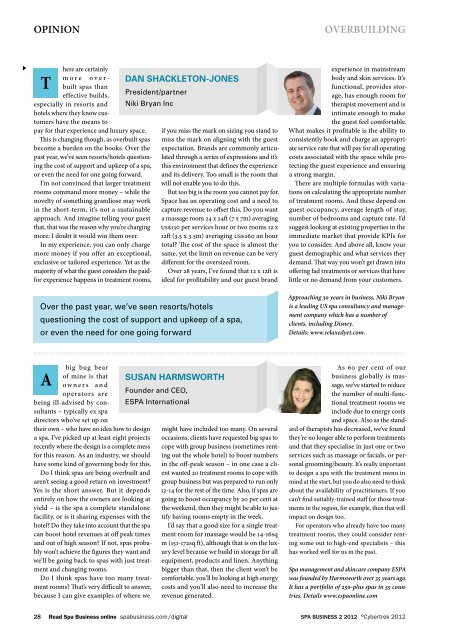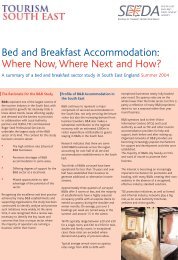Spa Business issue 2 2012 - Leisure Opportunities
Spa Business issue 2 2012 - Leisure Opportunities
Spa Business issue 2 2012 - Leisure Opportunities
You also want an ePaper? Increase the reach of your titles
YUMPU automatically turns print PDFs into web optimized ePapers that Google loves.
OPINION OVERBUILDING<br />
T<br />
here are certainly<br />
more overbuilt<br />
spas than<br />
effective builds,<br />
especially in resorts and<br />
hotels where they know customers<br />
have the means to<br />
pay for that experience and luxury space.<br />
Th is is changing though, as overbuilt spas<br />
become a burden on the books. Over the<br />
past year, we’ve seen resorts/hotels questioning<br />
the cost of support and upkeep of a spa,<br />
or even the need for one going forward.<br />
I’m not convinced that larger treatment<br />
rooms command more money – while the<br />
novelty of something grandiose may work<br />
in the short-term, it’s not a sustainable<br />
approach. And imagine telling your guest<br />
that, that was the reason why you’re charging<br />
more: I doubt it would win them over.<br />
In my experience, you can only charge<br />
more money if you offer an exceptional,<br />
exclusive or tailored experience. Yet as the<br />
majority of what the guest considers the paidfor<br />
experience happens in treatment rooms,<br />
big bug bear<br />
of mine is that A owners and<br />
operators are<br />
being ill-advised by consultants<br />
– typically ex spa<br />
directors who’ve set up on<br />
their own – who have no idea how to design<br />
a spa. I’ve picked up at least eight projects<br />
recently where the design is a complete mess<br />
for this reason. As an industry, we should<br />
have some kind of governing body for this.<br />
Do I think spas are being overbuilt and<br />
aren’t seeing a good return on investment?<br />
Yes is the short answer. But it depends<br />
entirely on how the owners are looking at<br />
yield – is the spa a complete standalone<br />
facility, or is it sharing expenses with the<br />
hotel? Do they take into account that the spa<br />
can boost hotel revenues at off peak times<br />
and out of high season? If not, spas probably<br />
won’t achieve the fi gures they want and<br />
we’ll be going back to spas with just treatment<br />
and changing rooms.<br />
Do I think spas have too many treatment<br />
rooms? Th at’s very diffi cult to answer,<br />
because I can give examples of where we<br />
DAN SHACKLETON-JONES<br />
President/partner<br />
Niki Bryan Inc<br />
28 Read <strong>Spa</strong> <strong>Business</strong> online spabusiness.com / digital<br />
if you miss the mark on sizing you stand to<br />
miss the mark on aligning with the guest<br />
expectation. Brands are commonly articulated<br />
through a series of expressions and it’s<br />
this environment that defi nes the experience<br />
and its delivery. Too small is the room that<br />
will not enable you to do this.<br />
But too big is the room you cannot pay for.<br />
<strong>Spa</strong>ce has an operating cost and a need to<br />
capture revenue to off set this. Do you want<br />
a massage room 24 x 24ft (7 x 7m) averaging<br />
us$130 per services hour or two rooms 12 x<br />
12ft (3.5 x 3.5m) averaging us$260 an hour<br />
total? Th e cost of the space is almost the<br />
same, yet the limit on revenue can be very<br />
diff erent for the oversized room.<br />
Over 28 years, I’ve found that 12 x 12ft is<br />
ideal for profi tability and our guest brand<br />
Over the past year, we’ve seen resorts/hotels<br />
questioning the cost of support and upkeep of a spa,<br />
or even the need for one going forward<br />
SUSAN HARMSWORTH<br />
Founder and CEO,<br />
ESPA International<br />
might have included too many. On several<br />
occasions, clients have requested big spas to<br />
cope with group business (sometimes renting<br />
out the whole hotel) to boost numbers<br />
in the off -peak season – in one case a client<br />
wanted 20 treatment rooms to cope with<br />
group business but was prepared to run only<br />
12-14 for the rest of the time. Also, if spas are<br />
going to boost occupancy by 20 per cent at<br />
the weekend, then they might be able to justify<br />
having rooms empty in the week.<br />
I’d say that a good size for a single treatment<br />
room for massage would be 14-16sq<br />
m (151-172sq ft ), although that is on the luxury<br />
level because we build in storage for all<br />
equipment, products and linen. Anything<br />
bigger than that, then the client won’t be<br />
comfortable, you’ll be looking at high energy<br />
costs and you’ll also need to increase the<br />
revenue generated.<br />
experience in mainstream<br />
body and skin services. It’s<br />
functional, provides storage,<br />
has enough room for<br />
therapist movement and is<br />
intimate enough to make<br />
the guest feel comfortable.<br />
What makes it profi table is the ability to<br />
consistently book and charge an appropriate<br />
service rate that will pay for all operating<br />
costs associated with the space while protecting<br />
the guest experience and ensuring<br />
a strong margin.<br />
Th ere are multiple formulas with variations<br />
on calculating the appropriate number<br />
of treatment rooms. And these depend on<br />
guest occupancy, average length of stay,<br />
number of bedrooms and capture rate. I’d<br />
suggest looking at existing properties in the<br />
immediate market that provide KPIs for<br />
you to consider. And above all, know your<br />
guest demographic and what services they<br />
demand. Th at way you won’t get drawn into<br />
off ering fad treatments or services that have<br />
little or no demand from your customers.<br />
Approaching 30 years in business, Niki Bryan<br />
is a leading US spa consultancy and management<br />
company which has a number of<br />
clients, including Disney.<br />
Details: www.relaxedyet.com.<br />
As 60 per cent of our<br />
business globally is massage,<br />
we’ve started to reduce<br />
the number of multi-functional<br />
treatment rooms we<br />
include due to energy costs<br />
and space. Also as the standard<br />
of therapists has decreased, we’ve found<br />
they’re no longer able to perform treatments<br />
and that they specialise in just one or two<br />
services such as massage or facials, or personal<br />
grooming/beauty. It’s really important<br />
to design a spa with the treatment menu in<br />
mind at the start, but you do also need to think<br />
about the availability of practitioners. If you<br />
can’t fi nd suitably-trained staff for those treatments<br />
in the region, for example, then that will<br />
impact on design too.<br />
For operators who already have too many<br />
treatment rooms, they could consider renting<br />
some out to high-end specialists – this<br />
has worked well for us in the past.<br />
<strong>Spa</strong> management and skincare company ESPA<br />
was founded by Harmsworth over 35 years ago.<br />
It has a portfolio of 250-plus spas in 55 countries.<br />
Details www.espaonline.com<br />
SPA BUSINESS 2 <strong>2012</strong> © Cybertrek <strong>2012</strong>

















